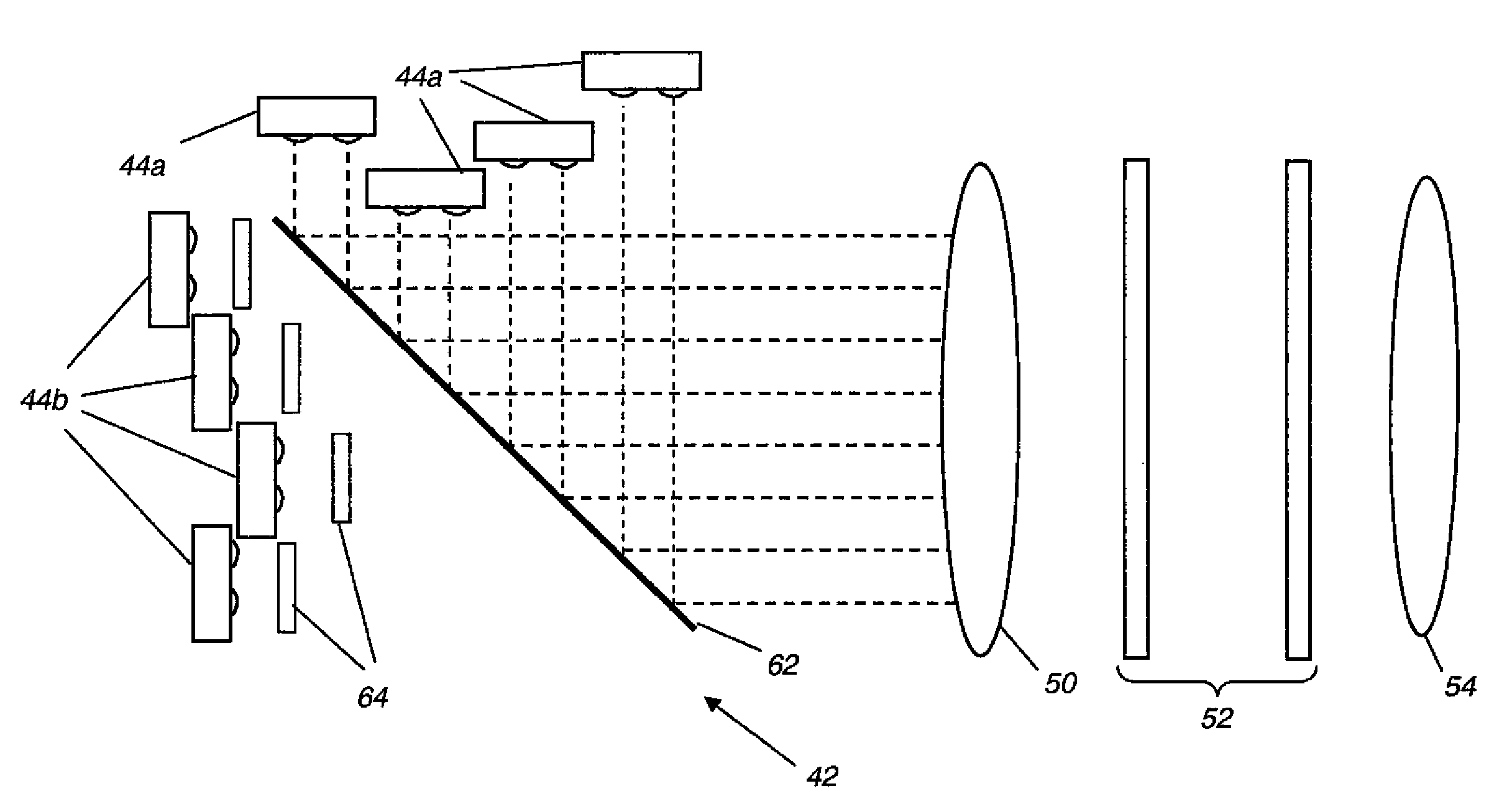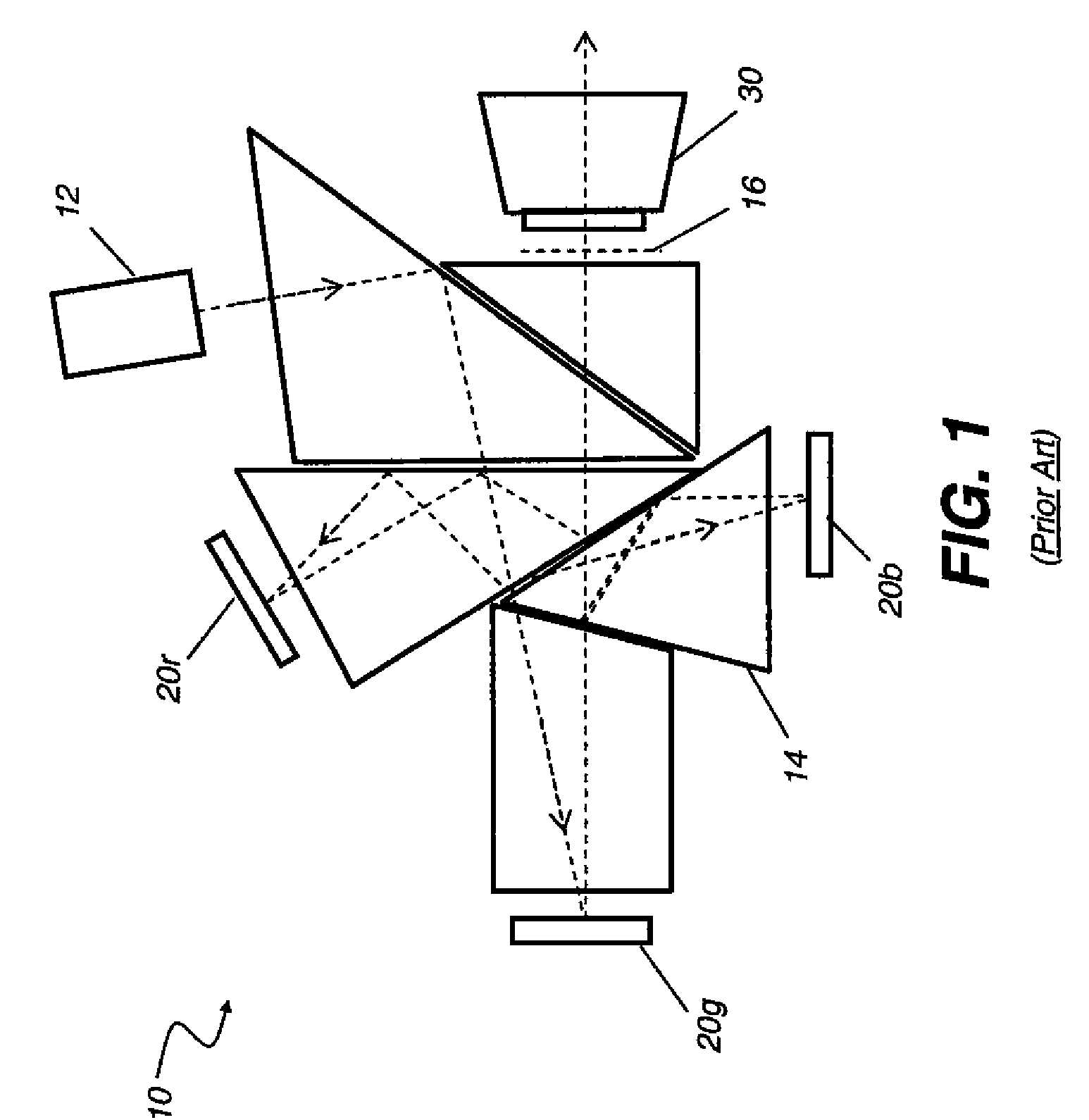However, there are inherent resolution limitations, with existing devices typically providing no more than 2048×1080 pixels.
In addition, high component and
system costs have limited the suitability of DLP designs for higher-quality digital cinema projection.
Moreover, the cost, size, weight, and complexity of the Philips
prism or other suitable combining prisms are significant constraints.
In addition, the need for a relatively fast
projection lens with a long working distance, due to brightness requirements, negatively impacts the acceptability and
usability of these devices.
However, with LCD components it can be difficult to maintain the high quality demands of digital cinema, particularly with regard to color and contrast, since the high
thermal load of high brightness projection affects polarization qualities of these devices.
A continuing problem with illumination efficiency relates to etendue or, similarly, to the Lagrange invariant.
Similarly, increasing the
source image size, so that light originates over a larger area, increases etendue.
Larger image sizes, however, typically result in a more costly
system.
This is especially true of devices such as LCOS and DLP components, where the
silicon substrate and defect potential increase with size.
As a general rule, increased etendue results in a more complex and costly optical design.
Moreover, although a configuration such as that disclosed in the '437 Sprotbery et al. disclosure handles light from three times the area of the final multicolor image formed, this configuration does not afford any benefit of increased brightness, since each color path contains only one-third of the total
light level.
Poorly matched etendue means that the optical
system is either light-starved, unable to provide sufficient light to the spatial light modulators, or inefficient, effectively discarding a substantial portion of the light that is generated for modulation.
LCD-based systems have been compromised by the requirement for polarized light, reducing efficiency and increasing etendue, even where polarization
recovery techniques are used.
DLP device designs, not requiring polarized light, have proven to be somewhat more efficient, but still require expensive, short lived lamps and costly optical engines, making them too expensive to compete against conventional cinema projection equipment.
Projection apparatus that meet these requirements typically cost in excess of $50,000 each and utilize high wattage
Xenon arc lamps that need replacement at intervals between 500-2000 hours, with typical replacement cost often exceeding $1000.
The large etendue of the
Xenon lamp has considerable
impact on cost and complexity, since it necessitates relatively fast
optics to collect and project light from these sources.
One drawback common to both DLP and LCOS LCD spatial light modulators (SLM) has been their limited ability to use
laser light sources, particularly
laser sources.
Solid-state lasers promise improvements in etendue,
longevity, and overall spectral and brightness stability but, until recently, have not been able to deliver visible light at sufficient levels and at costs acceptable for digital cinema.
However, brightness itself is not yet high enough; the combined light from as many as 9 individual arrays is needed in order to provide the necessary brightness for each color.
However, conventional solutions using these devices have been prone to a number of problems.
One limitation relates to device yields.
Due largely to heat and packaging problems for critical components, the commercialized VECSEL array is extended in length, but limited in height; typically, a VECSEL array has only two rows of emitting components.
The use of more than two rows tends to increase yield difficulties dramatically.
In addition, conventional VECSEL designs are prone to difficulties with power connection and heat sinking.
Thus, there can be significant current requirements and
heat load from the unused current.
Coupling of the laser sources to the
projection system presents another difficulty that is not adequately addressed using conventional approaches.
However, these are more difficult to
package in array form and traditionally have a shorter lifetime at higher brightness levels.
This random intensity fluctuation lowers the effective MTF of an image, especially at the higher frequencies essentially producing a “shimmer effect” in detail, but also creating an intensity sharpness that is really artificial.
In addition, in many cases a single approach may not be effective enough to reduce the speckle below acceptable thresholds.
Specially designed screens and screen shaking can be effective, however, they require modification to the venue that is undesirable, as being able to show a quality on any screen is preferred.
Similarly, if a polarization maintaining screen is desired adding additional constraints or features may be prohibitively expensive or difficult.
Large screens are especially difficult to modify manufacturing processes, as the equipment is large and expensive.
Spectrally broadening may be desirable, however, this may be difficult to control in the
laser fabrication, as many methods of creating visible
solid state sources desired for display applications use frequency double crystals that control the
wavelength to around 1 nm.
Changing diffusers is very effective, however, this increases the etendue of the sources by creating additional angular extent and requires a relatively expensive and controlled surface treatment on a glass surface in order to be durable for high-powered systems.
First, increasing the number of lasers that are substantially incoherent with respect to each other is used.
As described earlier, although increasing the number of lasers is effective at reducing speckle, it is, however, an incomplete solution.
The additional methods described in this patent are difficult to implement, expensive or undesirable optically.
This is undesirable for general projection purposes.
While U.S. Pat. No. 6,445,487 by Roddy et al. describes methods that use
frequency modulation of the lasers and / or in conjunction with a device to deviate the beam angularly in time, this method requires
laser modulation that may not be practical or possible for all laser sources.
These devices are very expensive and can only
handle certain laser types and sizes.
Thus, it can be seen that the challenge of providing a color
laser projection system having cinema quality nearly speckle free performance in uniformity and brightness has not been met.
 Login to View More
Login to View More  Login to View More
Login to View More 


